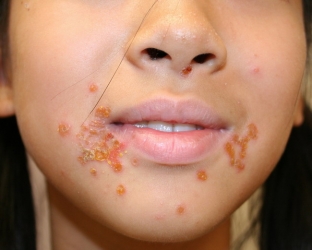Scaly patches on the legs that are pinkish in color and round in shape, which appeared on the legs after a strong and prolonged hypothermia of the legs, may indicate that the patient is developing streptoderma. This disease is caused, as a rule, by streptococci and is explained by a violation of metabolic processes in the skin. The reasons for such a violation may be different, but the skin is affected in the same way and causes serious suffering to the patient, and in case of untimely treatment, streptoderma can turn into eczema.
Why does streptoderma develop and how to recognize it
The essence of the problem, due to which streptoderma develops, is a violation of the supply of oxygen to the tissues in one place or another – most often in the shin area. The cause of circulatory disorders can be:
- exacerbation of varicose veins;
- obliterating diseases of the legs (thrombophlebitis);
- prolonged standing;
- severe hypothermia for a long time.
The inflammatory process in streptoderma usually immediately covers large areas of the skin, and gradually spreads to the entire lower leg. The skin lesion usually has a purple-bluish color and scalloped outlines, the skin is covered with large purulent-serous dried crusts, and if such a dried plate is lifted, then there will be a continuous weeping surface below. The plates on the affected surface may be brownish or even greenish-yellow. When the process subsides and wetting stops, dense scales spread over the skin. The affected area of the skin with streptoderma has a clear visual limitation in the form of a pink border of the exfoliating stratum corneum.

Diffuse streptoderma can take both an acute form – when the patient's temperature rises and the rash appears in waves, resembling the manifestations of impetigo, and paratraumatic – when the process becomes protracted, skin ulcers do not heal for a very long time, and new foci of inflammation begin to develop around them.
Peculiarities of the course of streptoderma and principles of treatment
The course of diffuse streptoderma is most often chronic, the disease is prone to recurrence. If the lesion does not heal for a long time and at the same time is injured or irritated by some substance, a sudden deterioration in the general condition of the patient may occur. Chills, malaise develops, a headache appears, the temperature rises, and against this background it is strictly symmetrical & nbsp; a small pink rash of spots and vesicles appears on the legs, which cause itching and last about 10 days. Then the rash is replaced by scaly scales and gradually disappears, leaving no marks on the skin.
With long-term non-healing weeping, eczematization of the process occurs. Against the background of inflamed skin, point erosions develop, from which a serous fluid is released.
The treatment of streptoderma begins, first of all, with the elimination of the causes that caused skin hypoxia and the development of inflammation. Prescribe drugs that restore blood circulation (as well as B vitamins, ascorutin), antibiotic therapy is recommended. Local treatment – for weeping surfaces, disinfectant dressings with silver nitrate or zinc sulfate are used, & nbsp; with a decrease in inflammation, ointments with aniline dyes can be used. The remnants of inflammatory infiltration are eliminated using concentrated sulfur-tar ointments.







Add a comment